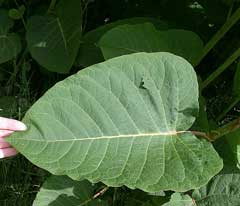 |
|
www.flickr.com/photos/urtica |
 |
|
Translate this page:
Summary
Physical Characteristics

 Reynoutria sachalinensis is a PERENNIAL growing to 3.6 m (11ft) by 3 m (9ft) at a fast rate.
Reynoutria sachalinensis is a PERENNIAL growing to 3.6 m (11ft) by 3 m (9ft) at a fast rate.
See above for USDA hardiness. It is hardy to UK zone 5. It is in flower from July to October, and the seeds ripen from August to October. The species is dioecious (individual flowers are either male or female, but only one sex is to be found on any one plant so both male and female plants must be grown if seed is required). . The plant is not self-fertile.
Suitable for: light (sandy), medium (loamy) and heavy (clay) soils. Suitable pH: mildly acid, neutral and basic (mildly alkaline) soils. It can grow in semi-shade (light woodland) or no shade. It prefers moist soil.
UK Hardiness Map
US Hardiness Map
Synonyms
Reynoutria sachalinensis. (Freidrich.Schmidt.&Petrop.)Nakai.
Plant Habitats
Edible Uses
Young shoots in spring - raw or cooked[46, 61, 116, 183]. They can be added to salads or cooked as an asparagus substitute[183]. They have an acid flavour and we find that they are more like a rhubarb substitute. Older stems and shoot tips - cooked. The stems are best peeled. Tasting like a mild version of rhubarb, they have a superior quality with a hint of lemon in the flavour[183]. Seed - cooked[105]. The seed can be ground into a powder and used as a thickener and flavouring in soups etc, or as an extender in flour. It is rather small and fiddly to utilize.
References More on Edible Uses
Medicinal Uses
Plants For A Future can not take any responsibility for any adverse effects from the use of plants. Always seek advice from a professional before using a plant medicinally.
None known
References More on Medicinal Uses
The Bookshop: Edible Plant Books
Our Latest books on Perennial Plants For Food Forests and Permaculture Gardens in paperback or digital formats.

Edible Tropical Plants
Food Forest Plants for Hotter Conditions: 250+ Plants For Tropical Food Forests & Permaculture Gardens.
More

Edible Temperate Plants
Plants for Your Food Forest: 500 Plants for Temperate Food Forests & Permaculture Gardens.
More

More Books
PFAF have eight books available in paperback and digital formats. Browse the shop for more information.
Shop Now
Other Uses
A potential source of biomass. Plants are very vigorous and could be grown as a ground cover[208].
Special Uses
References More on Other Uses
Cultivation details
Succeeds in ordinary garden soil in sun or shade[1, 111]. Hardy to about -25°c[187]. An extremely invasive plant, capable of sending up new shoots at a considerable distance from the main clump[1]. Considered a pest in many areas, if grown in the garden it should be planted within a barrier to contain its roots. Plants seem to be immune to the predations of rabbits[233]. Dioecious, male and female plants must be grown if seed is required.
References Carbon Farming Information and Carbon Sequestration Information
Temperature Converter
Type a value in the Celsius field to convert the value to Fahrenheit:
Fahrenheit:
The PFAF Bookshop
Plants For A Future have a number of books available in paperback and digital form. Book titles include Edible Plants, Edible Perennials, Edible Trees,Edible Shrubs, Woodland Gardening, and Temperate Food Forest Plants. Our new book is Food Forest Plants For Hotter Conditions (Tropical and Sub-Tropical).
Shop Now
Plant Propagation
Seed - sow spring in a cold frame. Germination is usually free and easy. When they are large enough to handle, prick the seedlings out into individual pots and plant them out in the summer if they have reached sufficient size. If not, overwinter them in a cold frame and plant them out the following spring after the last expected frosts. Division in spring or autumn. Very easy, larger divisions can be planted out direct into their permanent positions. We have found that it is better to pot up the smaller divisions and grow them on in light shade in a cold frame until they are well established before planting them out in late spring or early summer.
Other Names
If available other names are mentioned here
Native Range
TEMPERATE ASIA: Russian Federation (Kurile Islands (south), Sakhalin (south)), Japan (Hokkaidô, Honshu)
Weed Potential
Right plant wrong place. We are currently updating this section.
Please note that a plant may be invasive in one area but may not in your area so it’s worth checking.
Conservation Status
IUCN Red List of Threatened Plants Status :

Growth: S = slow M = medium F = fast. Soil: L = light (sandy) M = medium H = heavy (clay). pH: A = acid N = neutral B = basic (alkaline). Shade: F = full shade S = semi-shade N = no shade. Moisture: D = dry M = Moist We = wet Wa = water.
Expert comment
Author
F.Schmidt.
Botanical References
1758200
Links / References
For a list of references used on this page please go here
Readers comment
| Add a comment |
|
If you have important information about this plant that may help other users please add a comment or link below. Only comments or links that are felt to be directly relevant to a plant will be included. If you think a comment/link or information contained on this page is inaccurate or misleading we would welcome your feedback at [email protected]. If you have questions about a plant please use the Forum on this website as we do not have the resources to answer questions ourselves.
* Please note: the comments by website users are not necessarily those held by PFAF and may give misleading or inaccurate information.
To leave a comment please Register or login here All comments need to be approved so will not appear immediately.
|
Subject : Reynoutria sachalinensis
|
|
|
|